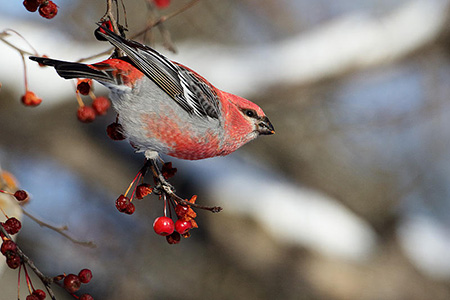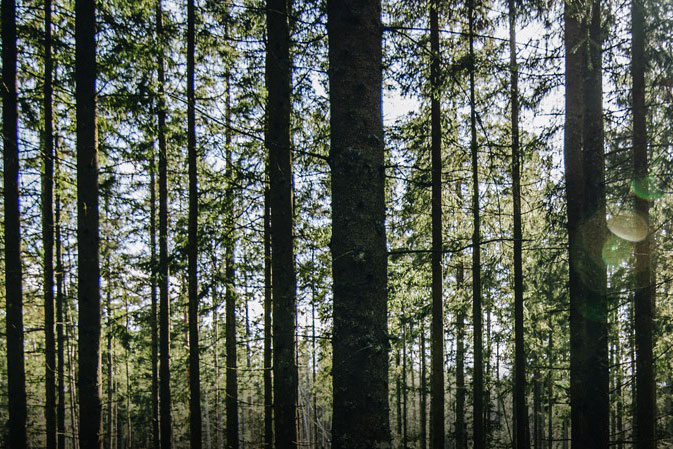The Pine Grosbeak is an inconspicuous species that is rarely observed except during years when their populations boom and they spread into new areas during the winter.
Pine Grosbeak
(Pinicola enucleator)
Habitat Ecology
- The Pine Grosbeak lives year-round within the Boreal Shield and across most of interior BC. Populations east of the Rockies have periodic “winter irruptions”, during which large numbers of birds move outside of their usual range, sometimes as far south as the Canada-US border. These irruptions occur every 5–25 years and are thought to be driven by food availability.1
- Pine Grosbeaks are most abundant in open coniferous (spruce, subalpine fir and tamarack) forests near the treeline (northern or montane), drainages and wet valleys.1
- They only breed in subalpine and subarctic open coniferous forests.1 In the winter, they will occupy a range of habitats including mixed coniferousdeciduous, deciduous, and second-growth forests.2 Wintering habitats are thought to be driven by availability of mountain ash, ash, and maple.1
- In BC, the Pine Grosbeak’s breeding range is now understood to be widespread. It is most common in the Northern Boreal Mountains and Sub-Boreal Interior ecoprovinces, particularly above 1,500 m, and in remote forests and parklands dominated by western hemlock, subalpine fir, white spruce, and Engelmann spruce.3

Response to Forest Management
- Pine Grosbeaks are very rarely observed, making it difficult to draw conclusions about their response to forestry.
- Studies in Finland show that Pine Grosbeaks are mainly observed in very old (>200 years) spruce or pine forests, and very rarely in thinned and/or fragmented forests.4,5 They are also positively associated with large, unharvested reserves, but negatively associated with the amount of pine forest in the reserves.6
Stand-level Recommendations
- Based on known habitat associations, the following habitat features are recommended for retention within harvested areas:
- Mountain ash trees and other berry-producing trees or shrubs.
- Wet areas containing sparse black spruce, tamarack, or other conifers.
- Given the Pine Grosbeak’s association with open coniferous stands during the breeding season, silviculture that promotes dense regeneration appears likely to reduce habitat quality. Harvesting is most likely to affect breeding habitats in BC, where they are more widespread, but more research is needed to determine the degree of overlap between breeding populations and harvesting, and the effect of harvest.
Landscape-level Recommendations
- While there is very little information available, it is likely that large, unharvested areas of old and/or open coniferous forests within the Pine Grosbeak’s breeding range will be of greatest benefit to this species.
- The passive landbase likely provides important high-quality breeding habitat, including wet, unproductive coniferous forests, sparse subalpine parklands, and remote or inaccessible forests. However, more research is required to confirm this assumption.
References
- Adkisson, C. S. 1999. Pine Grosbeak (Pinicola enucleator). In The Birds of North America (ed. Rodewald, P. G.) Cornell Lab of Ornithology, Ithaca, New York, USA. Available online: https://birdsna.org/Species-Account/bna/species/pingro
- B.C. Conservation Data Centre. 2018. Species Summary: Pinicola enucleator. B.C. Minist. of Environment Available online: http://a100.gov.bc.ca/pub/eswp/
- Martell, A. 2015. Pine Grosbeak. In The Atlas of the Breeding Birds of British Columbia, 2008-2012 (eds. Davidson, P. J. A., Cannings, R. J., Couturier, A. R., Lepage, D. & Corrado, C. M. Di) Bird Studies Canada, Delta, BC. Available online: http://www.birdatlas.bc.ca/accounts/speciesaccount.jsp?sp=PIGR&lang=en
- Virkkala, R. 1991. Population trends of forest birds in a Finnish Lapland landscape of large habitat blocks: Consequences of stochastic environmental variation or regional habitat alteration? Biological Conservation 56: 223–240. Available online: https://doi.org/10.1016/0006-3207(91)90019-6
- Virkkala, R. 1987. Effects of forest management on birds breeding in northern Finland. Annales Zoologici Fennici 24: 281–294. Available online: http://www.sekj.org/PDF/anzf24/anz24-281-294.pdf
- Brotons, L., Mönkkönen, M., Huhta, E., Nikula, A. & Rajasärkkä, A. 2003. Effects of landscape structure and forest reserve location on old-growth forest bird species in Northern Finland. Landscape Ecology 18: 377–393. Available online: https://link.springer.com/article/10.1023/A%3A1026148825138








